Situated along the banks of the Tagus River, it’s safe to say that the many beautiful views and exciting attractions in Belém, Lisbon, make it one of the top places to visit in the city!
The neighborhood of Belém is incredibly significant to the history of Lisbon, and–thanks to being spared during the infamous 1755 earthquake–is home to some of the oldest and most significant architecture in the city.
It’s also where Vasco da Gama famously set off on his journey to round the Cape of Good Hope, a voyage that shaped the history of Portugal and beyond.
That being said, despite the fact that some of the best things to do in Belém also easily rank among the best things to do in Lisbon overall, today’s Belém still feels decidedly separate from much of central Lisbon.
In many ways, visiting Belém almost feels like taking a day trip from Lisbon.
So, when you take the time to make the trek out, it’s a good idea to know exactly what to do in Belém!
We’ve chosen to focus this Belém travel guide on attractions that first-time visitors will typically be interested in, either because of how delightful they are or because they’re located virtually next door to other must-see sights.
However, if you’re a Lisbon local or have more time to spend in the area, we also highly recommend checking out more of the incredible things to do in Belém, such as the National Archaeological Museum and Calouste Gulbenkian Planetarium.
That being said, if you’re hoping to spend one day in Belém, this travel guide covers all the best things to do in one day and beyond.
Here are the best things to do in Belém, Lisbon, plus tips for visiting!
Table of Contents
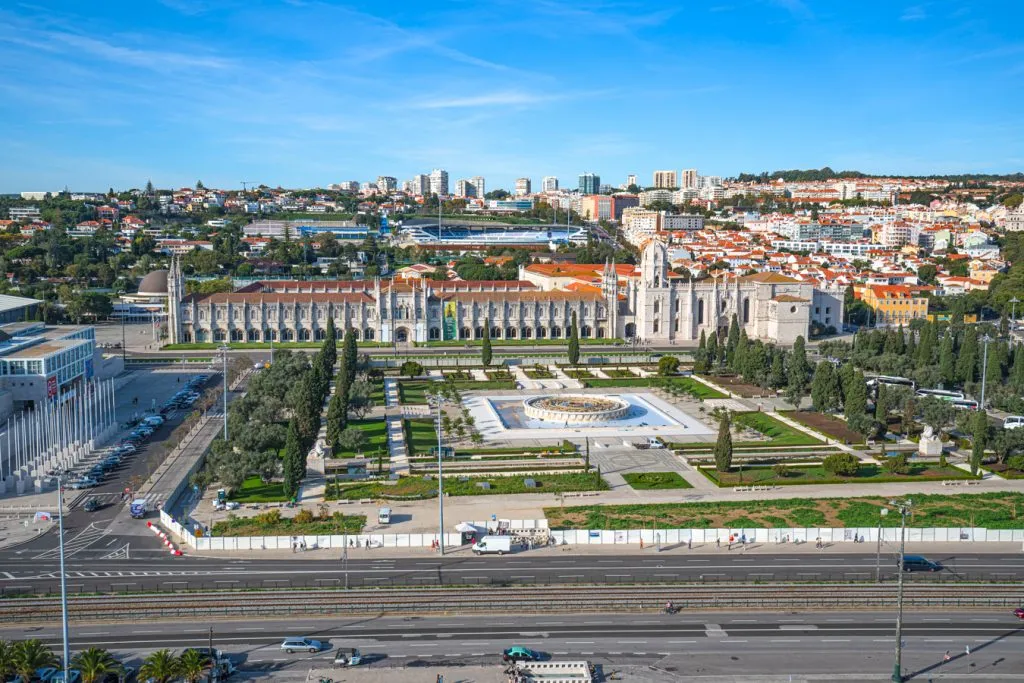
The Best Things to Do in Belém, Lisbon
Explore the famous Jerónimos Monastery.
Easily the most famous landmark in Belém, the iconic Jerónimos Monastery is a must-see when exploring this Lisbon neighborhood!
Built at the turn of the 16th century, the Jerónimos Monastery is one of the most fantastic buildings in all of Portugal and a UNESCO World Heritage Site.
Considered one of the best examples of the detailed, opulent Gothic Manueline architecture in Lisbon, the Jerónimos Monastery (also called the Hieronymites Monastery) dwarfs the rest of Belém to this day.
As you approach, imagine how imposing this gigantic, detailed building would have been in the 1500s, when the rest of Belém was more or less undeveloped.
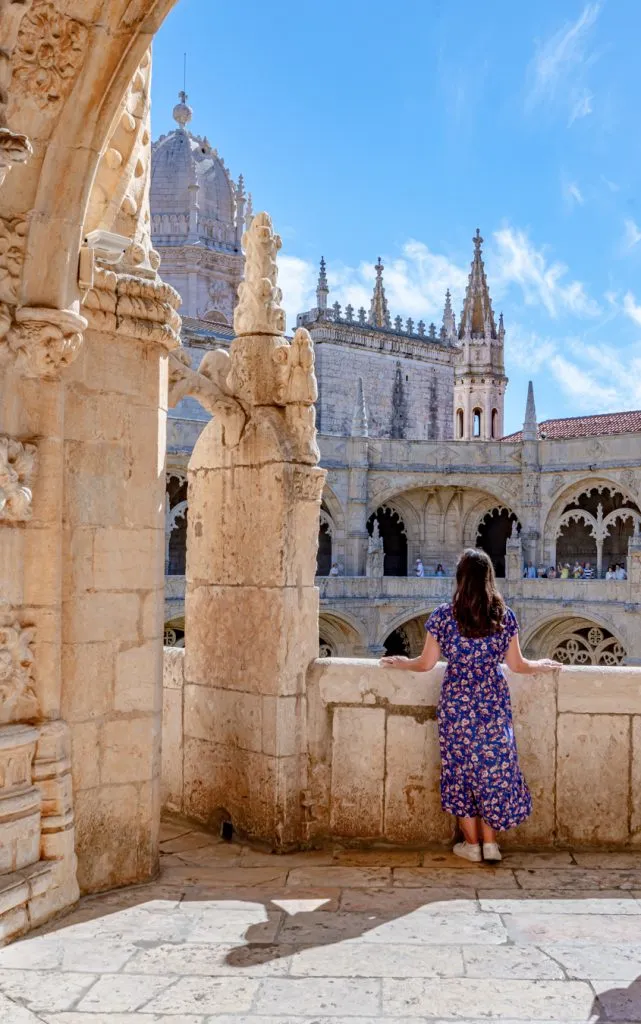
Spared in the earthquake of 1755 (fun fact: happening to be in Belém at the time is also what spared the Portuguese royal family on that fateful day), the Jerónimos Monastery is one of the oldest monuments in Lisbon that was not reconstructed.
It also happens to be ridiculously popular.
We strongly recommend buying your tickets in advance and arriving before the doors open at 10:00 AM to ensure you can enjoy this landmark without dedicating too much of your time in Belém to it.
Bear in mind that you will need to wait in line twice to view every part of the monastery: the ticketed portion, which includes the famous cloisters, should be your first stop.
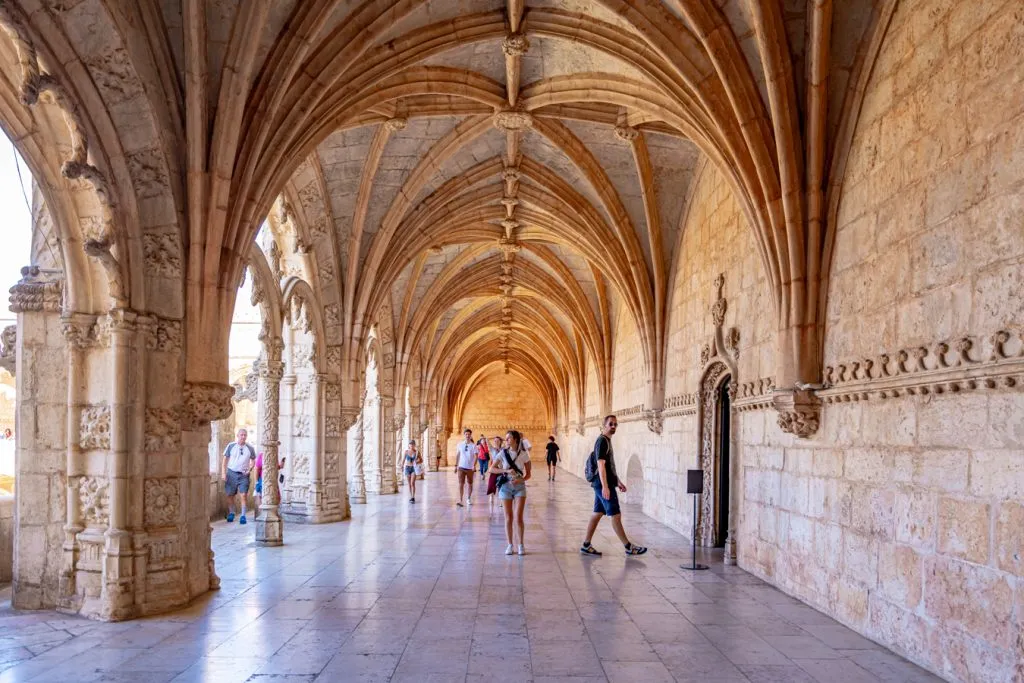
… and the Church of Santa Maria de Belém.
Physically attached to the Jerónimos Monastery but visited via a separate entrance (that includes its own line), the Church of Santa Maria de Belém is one of the most significant churches in Lisbon.
With soaring ceilings and beautiful details, this Manueline church would be worth a visit for its architecture alone.
Its significance to Portuguese history, though, comes more from the many tombs found there.
The tombs include those of King Manuel I (the man behind Manueline architecture), Luís de Camões (a beloved poet), and most famously, Vasco da Gama (the first European to round the Cape of Good Hope and successfully sail from Europe to India).
All 3 figures were important to Portugal’s Age of Discovery, which resulted in Lisbon’s importance and wealth at the time that the Jerónimos Monastery and Church of Santa Maria de Belém were being constructed.
Unlike the monastery itself, the church is free to visit.
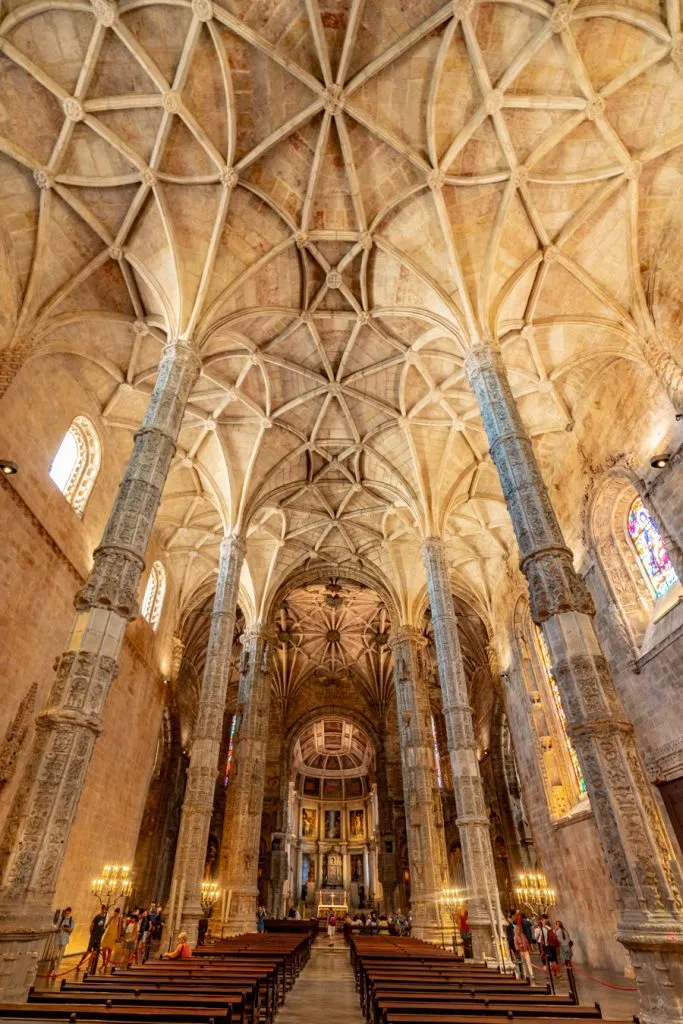
Sample Lisbon’s most famous pastéis de nata.
When it comes to Portugal’s most famous pastry, one bakery has a reputation above all others: Pastéis de Belém, home to the original pastéis de nata.
Baked from a recipe that has been a closely guarded secret for generations (ever since the original proprietor purchased it from the monks at the nearby Jerónimos Monastery), these sweet treats are known for their incredible taste… and their long lines.
Instead of opting for the generally crowded takeaway line, grab a table via the (typically shorter) table service line and settle in for a memorable snack.
Their spacious dining room reminds me vividly of Cafe du Monde in New Orleans!
Whether or not these are really the best pastéis de nata in Lisbon is a matter of intense debate, but they are absolutely delicious (I’m an especially big fan of the crust).

Visit the Monument to the Discoveries.
One of the most famous landmarks in Belém, the Monument to the Discoveries (or Padrão dos Descobrimentos) was erected in 1960 as an ode to the Portuguese Age of Discovery.
The monument is striking and feels very much like what it is: a heavily romanticized take on Portuguese history erected under the direction of dictator António de Oliveira Salazar.
Don’t expect any hard-hitting analysis of colonization here, despite the clear links between the monument and Portugal’s long colonial history.
The interior of the monument has a small, somewhat interesting museum about the revitalization of Belém in the 20th century.
The real draw of visiting, though, is the view from the top: commanding views of the Ponte 25 de Abril Bridge, Tagus River, Belém Tower, Jerónimos Monastery, and more, make the view from the top of the Monument to the Discoveries one of the best views in Lisbon.
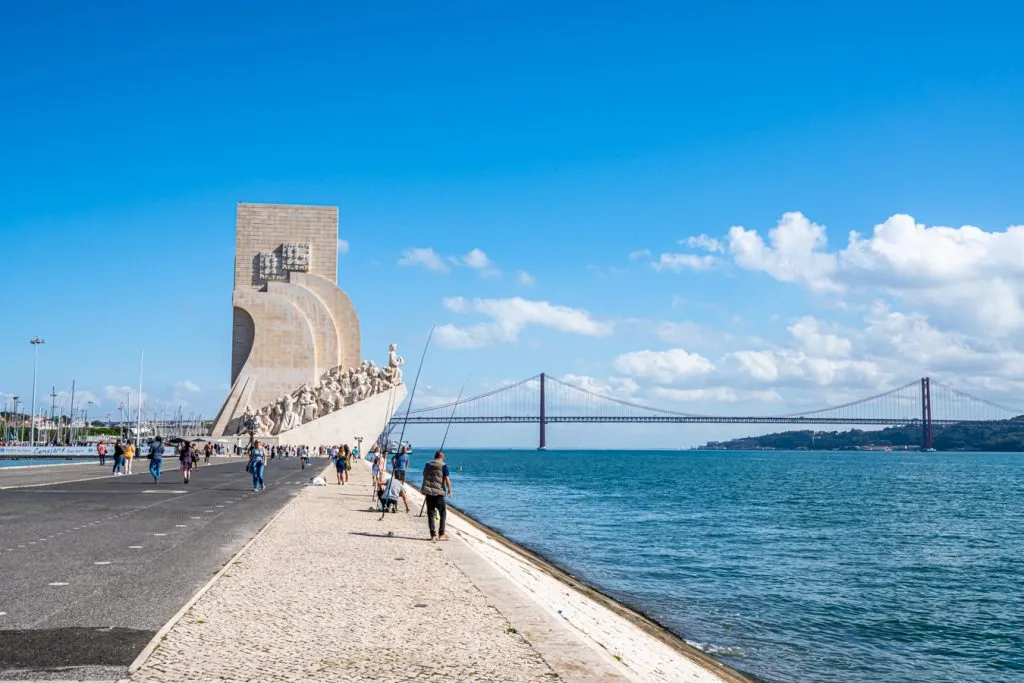
… and take a peek at the Water Mirror next door.
More of a point of interest than a full-blown attraction, the Lisbon Water Mirror can be found right next door to the Monument to the Discoveries (you can see it to the right in the below photo).
Built in 1940 for the Portuguese World Exhibition, the Water Mirror is an interesting example of mid-20th-century architecture in Portugal.
At the time it was built, a full 20 years before the Monument to the Discoveries was erected, the Water Mirror was one of many planned projects designed to revitalize the Belém waterfront.
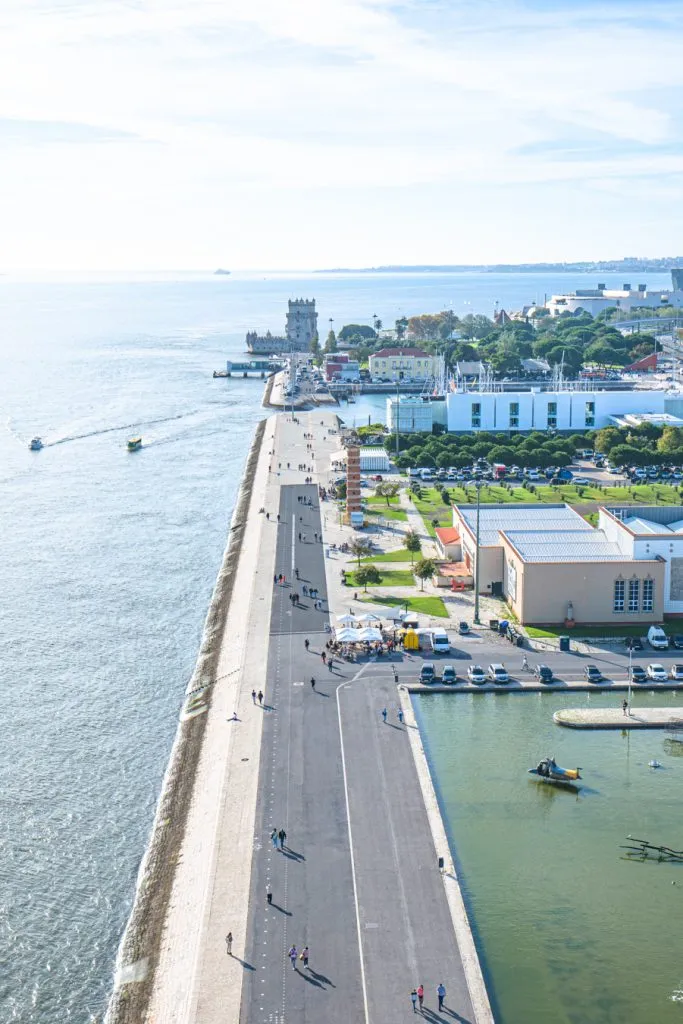
Explore the National Coach Museum.
Lisbon’s National Coach Museum is one of those wonderful museums that takes a topic many of us have very little knowledge about and makes it fascinating.
Home to one of the world’s best collections of horse-drawn carriages, the National Coach Museum is a delight to explore.
The carriages date between the 17th and 19th centuries, and include everything from jaw-dropping, opulent carriages used by royalty for ceremonial purposes to a 19th-century mail coach and even a jail coach!
The carriages are arranged more or less by time period, and as you travel through the museum, you’ll find that the coaches get sleeker, simpler, and more and more familiar as the timeline inches toward the revolution of “horseless carriages”.
I love this museum and highly recommend it, but it isn’t the cheapest museum in Lisbon with tickets starting at 8 Euro.
If you plan to visit, you may want to price out whether a Lisbon Card (as of the time of writing, the National Coach Museum is an included attraction) is right for your visit to Belém.
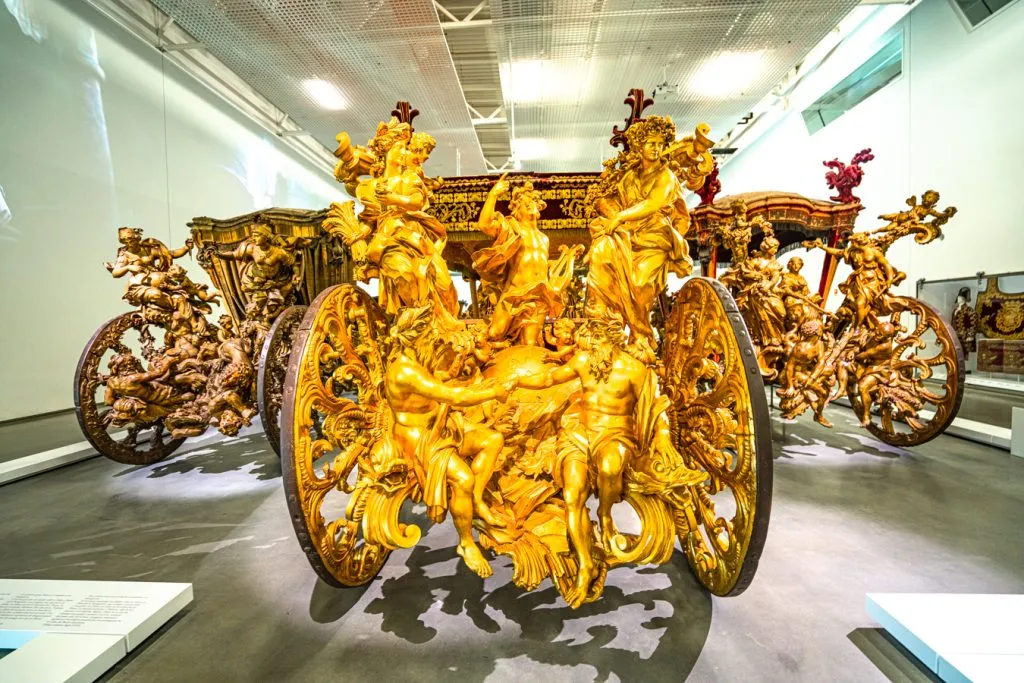
Check out the Museum of Art, Architecture, and Technology (MAAT).
The Museum of Art, Architecture, and Technology (more commonly referred to as the MAAT) is one of Lisbon’s most striking and recognizable museums.
Held partially in the refurbished Tejo Power Station that dates to the first half of the 20th century and partially in the sleek new building that is itself a work of art, the MAAT is a must-visit attraction in Belém.
… And that goes for whether you have time to go inside or not!
In addition to being a wonderful museum, the exterior of the MAAT, including the rooftop of its new building and the banks of the Tagus River where it is situated, is one of Lisbon’s best sunset spots.
The views of the river, Ponte 25 de Abril Bridge, Christ the King Statue, and more are incredible, and that’s before you even consider how the light of the setting sun plays with the architecture of the building itself.
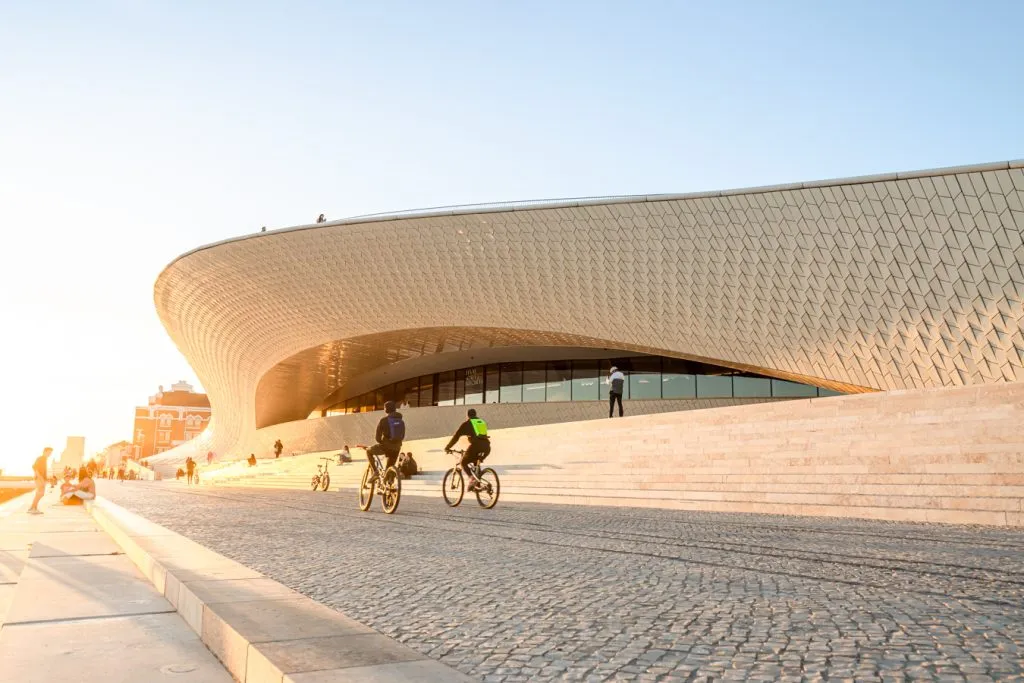
Hop on a sailboat cruise along the Tagus River.
One of the best things to do in Lisbon is to cruise along the Tagus River in a sailboat, soaking in gorgeous views of the city and its monuments (including the most famous landmarks in Belém) along the way.
And, since most Lisbon sailboat cruises leave from Belém, hopping onboard is a wonderful addition to any Belém itinerary!
The views of Lisbon from the Tagus are fantastic, and there’s nothing quite like experiencing the city from the water.
Lisbon’s history and culture are deeply tied to the Tejo and to the wide open sea that lies beyond it, and relaxing on a sailboat is a fantastic way to reflect on your trip to the city.
Plus, it’s simply lots of fun, and more affordable than you might expect!
Book your Tagus River cruise today!
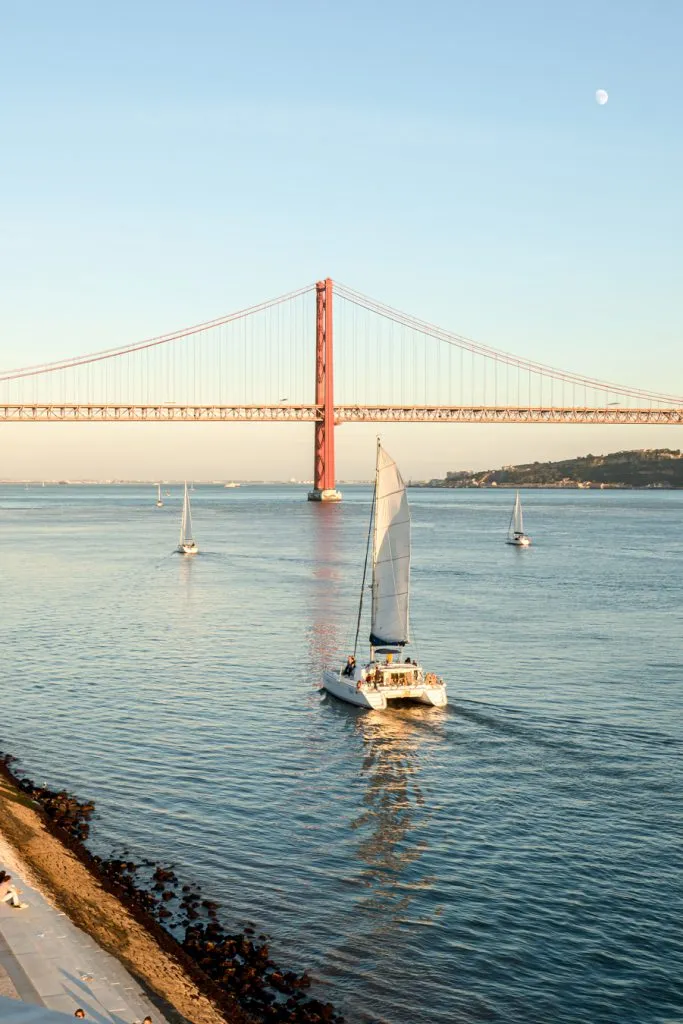
Check out the Tropical Botanical Garden.
Located just a 5-minute walk or so from popular attractions like the Jerónimos Monastery and Pastéis de Belém, the Tropical Botanical Garden is a peaceful hidden gem in Belém.
If you’re looking for a bit of quiet and greenspace to break up your time spent among some of Lisbon’s most crowded monuments, the Tropical Botanical Garden is a great stop!
Decorated with 18th-century Italian sculptures, art that dates to the 1940 Portuguese World Exhibition, and–most memorably–a large collection of roaming ducks, geese, swans, and more, the Tropical Botanical Garden is a fun side stop in Belém.
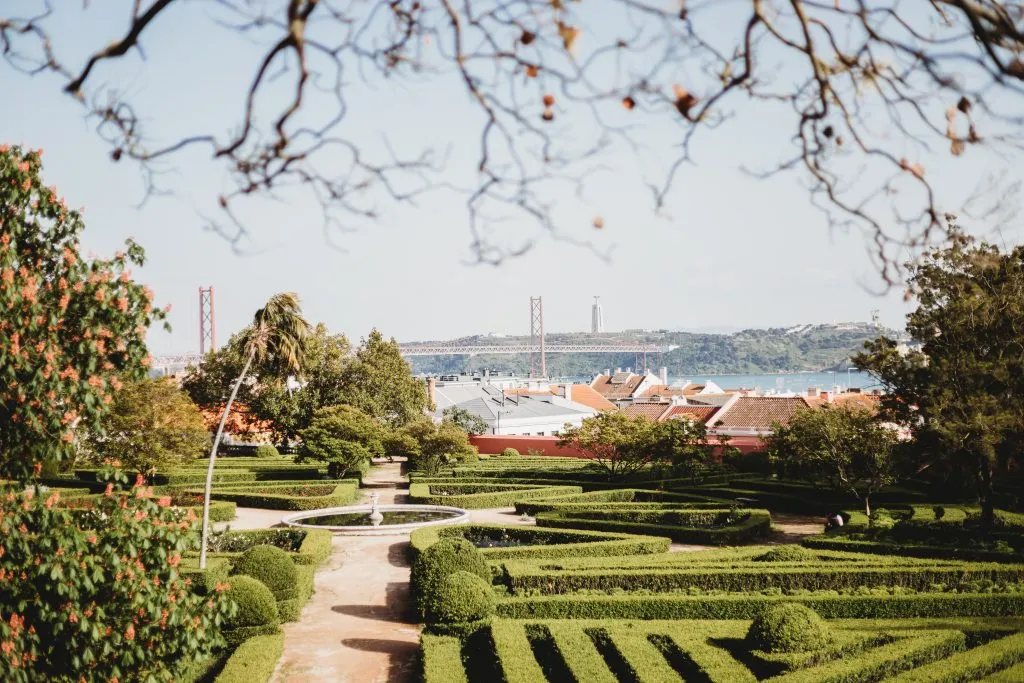
Explore the fascinating Maritime Museum.
Housing roughly 17,000 artifacts ranging from actual boats to the world’s largest collection of astrolabes, the Maritime Museum (sometimes called the Navy Museum) is one of the best places to visit in Belém.
Portugal’s relationship with the sea has deeply shaped its culture and history for centuries, both in the famous Age of Discovery and outside of it.
The Maritime Museum explores this relationship, and its collection is fascinating!
Plus, since the museum is housed in the western part of the Jerónimos Monastery, even the building itself is memorable.
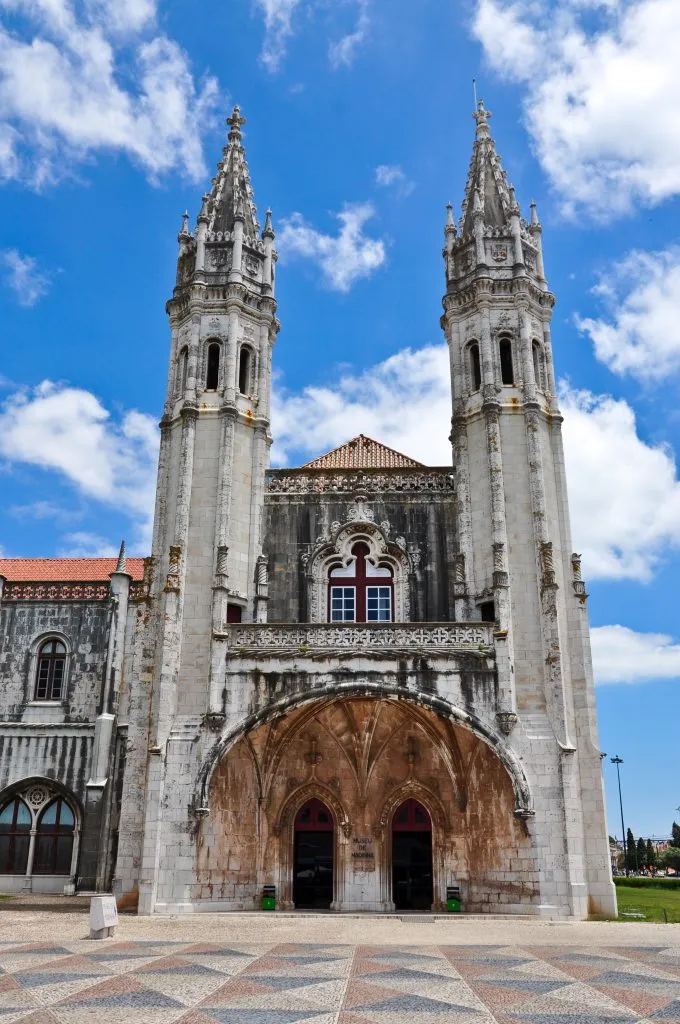
Pay a visit to the Berardo Collection Museum.
Housed in part of the Cultural Center of Belém, the Berardo Collection Museum started as an agreement between the government and Portuguese businessman José Berardo to publicly display part of Berardo’s extensive private art collection.
The agreement has since been renewed, and the Berardo Collection Museum is the perfect destination for modern and contemporary art lovers in Lisbon!
Featuring both permanent and rotating collections, the Berardo Collection Museum is a great option for visitors hoping to get off the beaten path in Belém.
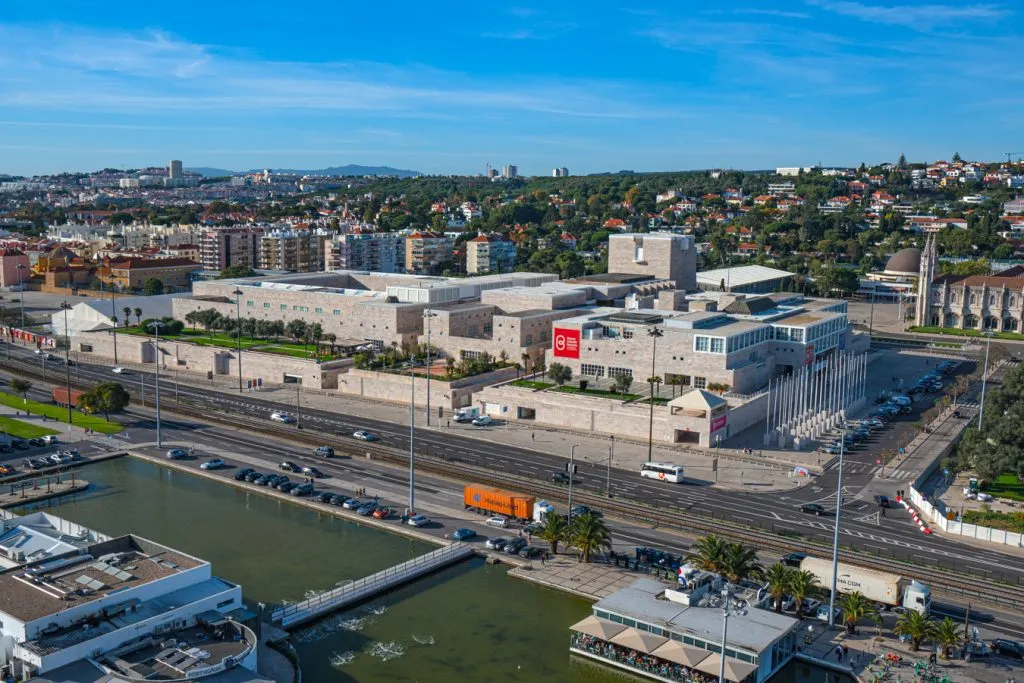
Spot the Thai pagoda in the Imperial Garden.
Belém’s shady, grass-covered Imperial Garden is a fantastic place to kick back, relax, and potentially enjoy a few pastéis de nata.
It’s also home to a beautiful Thai pagoda that was gifted to Portugal by Thailand!
As the Imperial Garden is conveniently located between the Jerónimos Monastery and the Monument to the Discoveries, odds are that you’ll naturally pass close by the pagoda while visiting Belém in Lisbon.

Watch the sunset over the Tagus River.
Whether you opt to enjoy the sunset from the banks of the Tagus River, from the roof of the MAAT, from a riverside bar, or from a stunning sunset sailboat cruise, there’s no doubt that enjoying a beautiful sunset is one of the best things to do in Belém.
Thanks to the neighborhood’s location along the banks of the river, Belém in general is a fantastic place to enjoy Lisbon’s spectacular sunsets.

Last but not least: stop by the gorgeous Belém Tower.
No guide to the best things to do in Belém is complete without covering the beautiful Belém Tower!
Done in the detailed Manueline style, the Belém Tower once served as a ceremonial entrance and exit point of Lisbon and is one of the most recognizable landmarks in the city.
While you can go inside, we don’t necessarily recommend it.
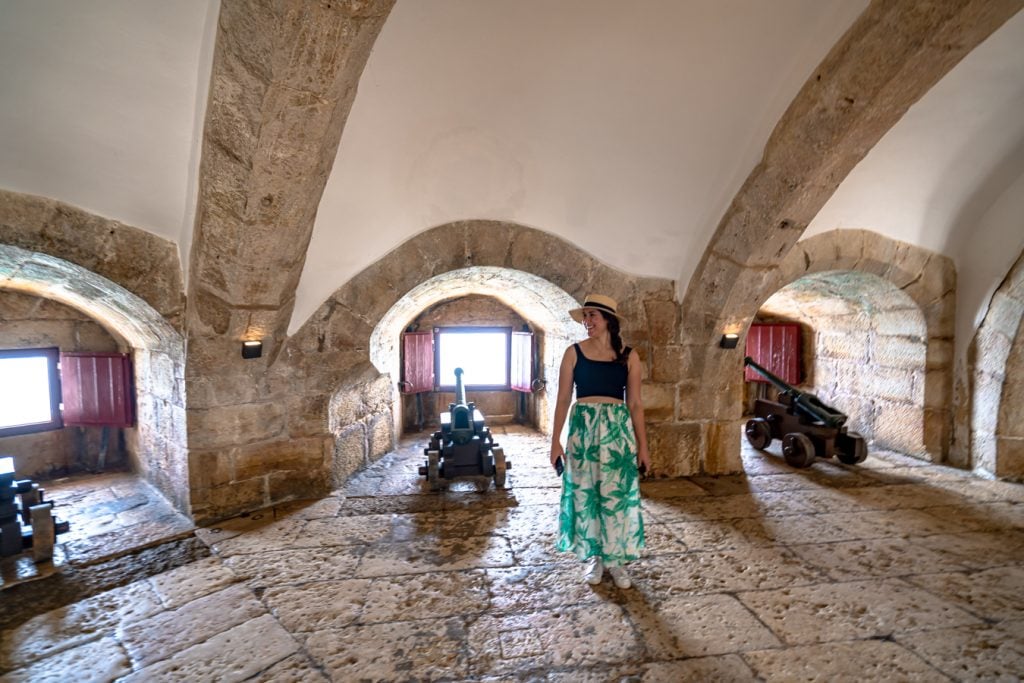
The interior is unfurnished, somewhat plain, and not large enough to accommodate the number of people who want to visit, resulting in having to wait in multiple lines.
The one time we went inside (on an iffy weather day in September), we felt more like we were constantly lining up for a Disney ride than exploring a historic structure!
If you’re a huge Portuguese architecture nerd, it may be worth it in the off-season (seeing the exterior of the building up close is lovely), but otherwise, we suggest sticking with enjoying the Belém Tower from the outside.
That being said, admiring the Belém Tower from the outside is absolutely worth it, and we recommend making time for it when structuring your itinerary for Belém!
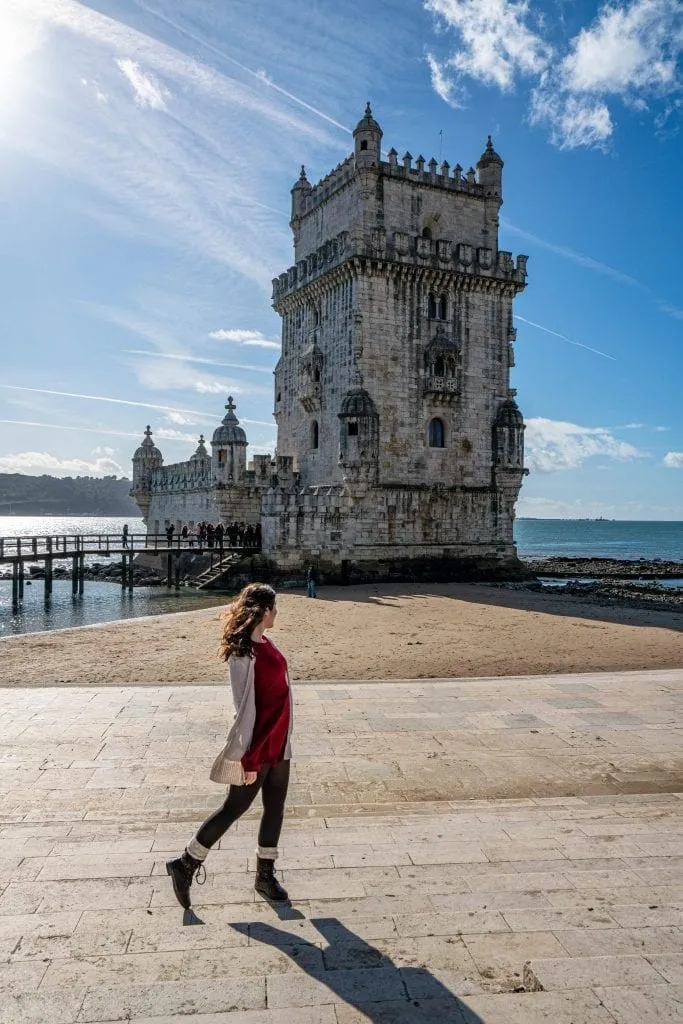
Sample One Day in Belém Itinerary
For most visitors on a short trip to Lisbon, spending most of one day in Belém–and not much more–makes sense.
Here’s how to make the most of your time!
Start your morning at Pastéis de Belém for a delicious, sweet breakfast (and yes, pastéis de nata absolutely counts as a breakfast food in Portugal.
From there, head over to the Jerónimos Monastery (with your pre-booked ticket) before it opens at 10:00 AM to experience the monastery and the Church of Santa Maria de Belém without the crowds.
If you’re hungry, after visiting the monastery and church is a great time to grab lunch.
We can highly recommend Taberna dos Ferreiros, or if you’d like something more casual, there are many takeaway trucks and snack options near our next stops.

When you’re ready, stroll through the Imperial Garden and follow directions to the underground tunnel where you can pass underneath the car traffic and stroll comfortably to the Monument to the Discoveries.
If you have time, you can enjoy the view from the top, if not, walk along the river (mostly, you’ll need to cut in at one point) past the Water Mirror and Belém Lighthouse until you arrive at the Belém Tower.
At this point, you can round out your Belém visit with a fun sailboat cruise along the Tagus River and consider the day well spent.
If you would like to squeeze in even more sightseeing, though, a visit to the National Coach Museum and/or MAAT, followed by watching the sunset over the river from the MAAT, is doable for ambitious travelers who hope to spend an entire day in Belém.

Other Cool Attractions Near Belém
When planning a day trip to Belém, there are a handful of attractions that, while not technically in the neighborhood, should be on your radar as you sketch your Lisbon itinerary.
Two of the most prominent of these are the Ajuda National Palace and the Instagram-famous LX Factory.
The Ajuda Palace, located uphill from Belém, was the final official residence of the Portuguese royal family before the revolution in 1910.
Originally commissioned in the wake of the earthquake of 1755, the palace took centuries to complete due to various political and economic upheavals.
Today, though, it is a gorgeous, furnished palace, and an interesting and beautiful alternative to the crowded palaces of Sintra.
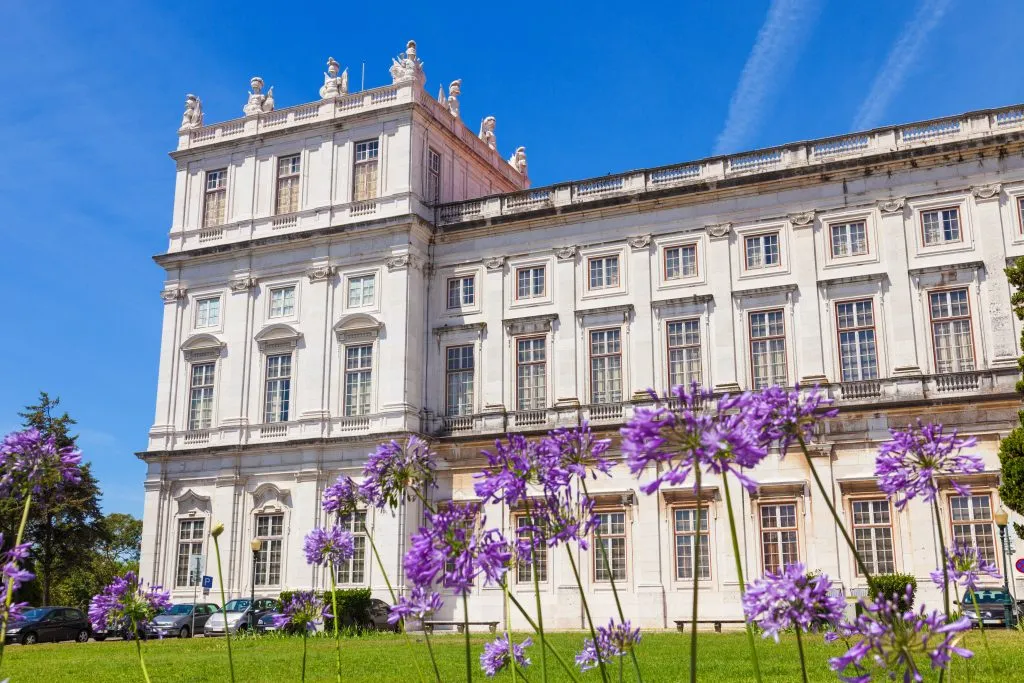
Meanwhile, the trendy LX Factory is one of the most popular places to visit in Lisbon and is conveniently located in Alcântara between central Lisbon and Belém.
Housed in a refurbished textile plant, LX Factory is home to countless shops, boutiques, artists, restaurants, and bars, and is one of Lisbon’s most beloved creative spaces.
This is also where you’ll find Ler Devagar, one of the city’s most popular (and photogenic) bookstores.
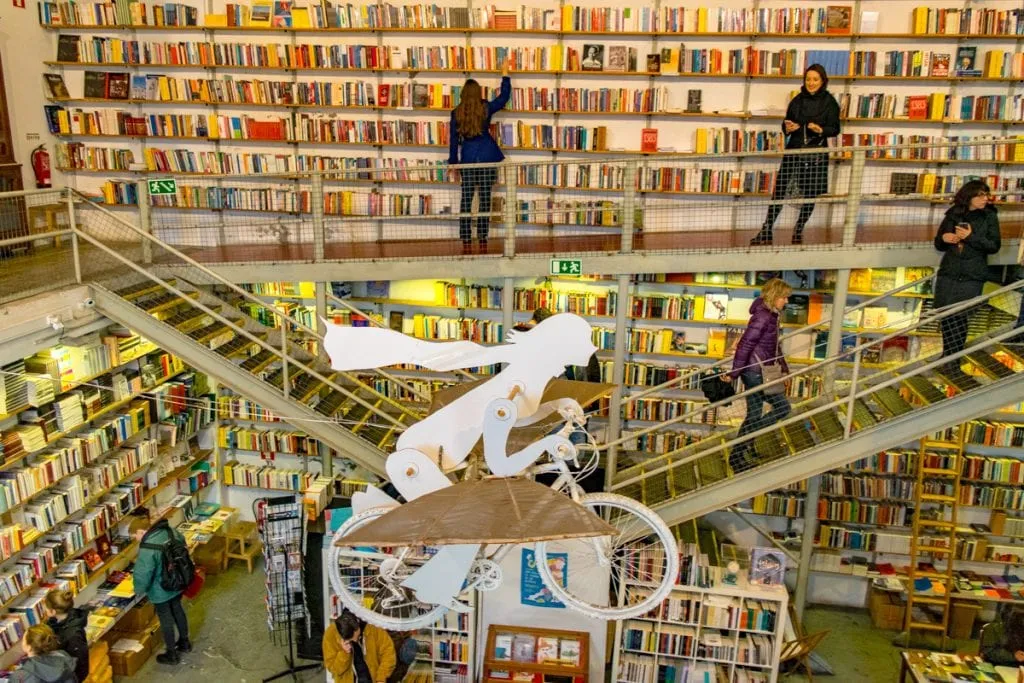
Is Belém a Good Place to Stay in Lisbon?
Since Belém is home to some of the best places to visit in Lisbon and is located right along the river, it’s easy to see why it looks like a great place to stay in Lisbon!
While Belém is a fantastic place to visit, it’s quite geographically isolated from most of the other best neighborhoods in Lisbon, and for most travelers planning their first trip to Lisbon, we’d recommend staying more central, in neighborhoods in like Alfama, Baixa, or Chiado.
That being said, visiting Belém is lots of fun, and if you have your heart set on staying out there (or are hoping to stay along the river but want to spend a bit less than you’d need to closer in), there are some great properties around.
The Altis Belém Design Hotel & Spa, featuring gorgeous views of the Tagus River and Ponte 25 de Abril, is a stunning property perfect for a relaxing retreat.
Alternatively, the Palacio do Governador makes for a stylish escape located just a short walk from the Belém Tower.

How to Get to Belém in Lisbon
Despite being located about 5 kilometers (or a little over 3 miles) from central Lisbon, Belém is simple to navigate to via public transportation.
The most popular way to get to Belém is via the 15 tram, which starts at Praça da Figueira and ends in Belém.
Keep in mind that this is a sleek, modern tram, rather than one of the historic yellow trams that help make Lisbon such a photogenic city.
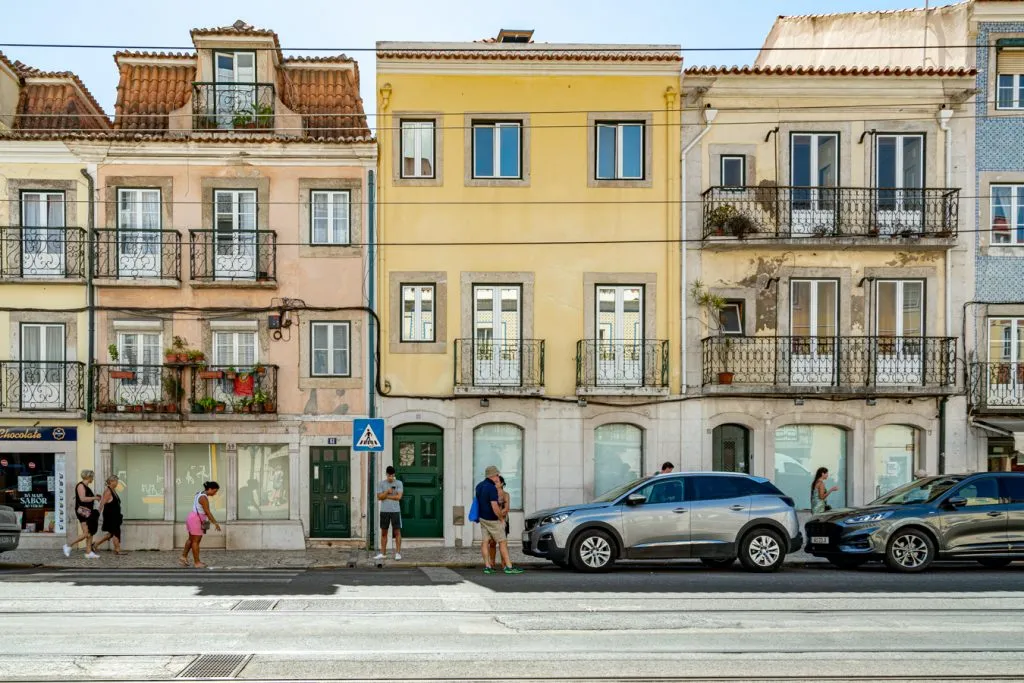
Be sure to watch out for pickpockets on this tram, too: as a popular route with tourists, it’s a bit of a hotspot for petty theft.
Alternatively, both the 714 and 728 bus routes travel to Belém as well.
Personally, we usually visit Belém via taxi, as Lisbon taxis are affordable, efficient, and reliably use the meter (with the exception of coming from the airport, but that’s a different story).
However you choose to get there, one thing is for sure: exploring the best things to do in Belém should definitely be part of your trip to Lisbon, Portugal!

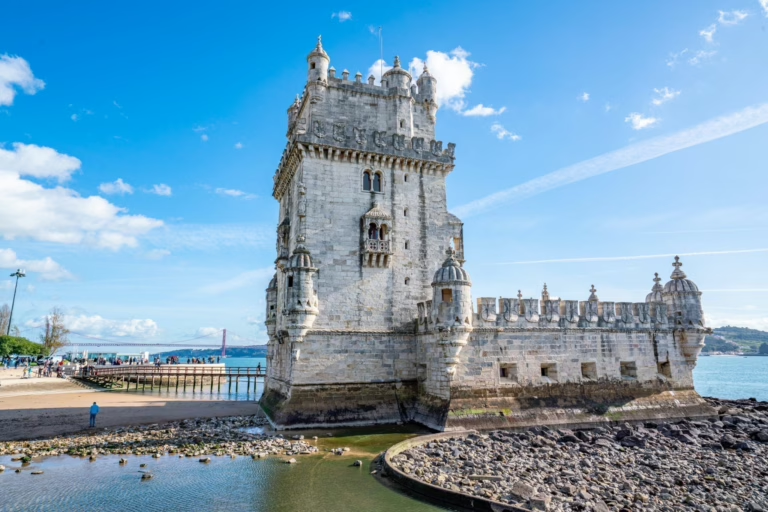
About Kate Storm